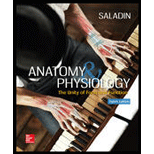
Concept explainers
A substance that ____ is considered to be a chemical compound.
- a. contains at least two different elements
- b. contains at least two atoms
- c. has a
chemical bond - d. has a stable valence shell
- e. has covalent bonds
Introduction:
Substances are made up of chemical components that are composed of either the same elements or different elements. It may be in different forms such as solid, liquid, and gaseous state.
Answer to Problem 1TYR
Correct answer:
A substance that contains at least two different elements is considered to be a chemical compound. Therefore, option a is correct.
Explanation of Solution
Justify reasons for the correct statement:
Substances that are composed of two or more different elements are said to be chemical compounds. Option (a) is given as “contains at least two different elements”. Hence, option (a) is correct.
Justify reasons for the incorrect statements:
Option (b) is given as “contains at least two atoms”, it is said to be diatomic in nature. Hence, it is a wrong answer.
Option (c) is given as “has a chemical bond” all atoms are joined by a chemical bond. Hence, it is a wrong answer.
Option (d) is given as “has a stable valence shell”. It is the outermost orbital of an atom. Hence, it is a wrong answer.
Option (e) is given as “has covalent bond”. It is defined as the chemical bond that shares two electrons of two different atoms. Hence, it is a wrong answer.
Hence, options (b), (c), (d), and (e) are incorrect.
Substances are made up of at least two different elements in a chemical component. Elements are linked by chemical bonds with different atoms. Substances may be in three different phases.
Want to see more full solutions like this?
Chapter 2 Solutions
Anatomy & Physiology: The Unity of Form and Function
Additional Science Textbook Solutions
Marine Biology (Botany, Zoology, Ecology and Evolution)
Genetics: Analysis and Principles
Biology: Concepts and Investigations
 Human Anatomy & Physiology (11th Edition)BiologyISBN:9780134580999Author:Elaine N. Marieb, Katja N. HoehnPublisher:PEARSON
Human Anatomy & Physiology (11th Edition)BiologyISBN:9780134580999Author:Elaine N. Marieb, Katja N. HoehnPublisher:PEARSON Biology 2eBiologyISBN:9781947172517Author:Matthew Douglas, Jung Choi, Mary Ann ClarkPublisher:OpenStax
Biology 2eBiologyISBN:9781947172517Author:Matthew Douglas, Jung Choi, Mary Ann ClarkPublisher:OpenStax Anatomy & PhysiologyBiologyISBN:9781259398629Author:McKinley, Michael P., O'loughlin, Valerie Dean, Bidle, Theresa StouterPublisher:Mcgraw Hill Education,
Anatomy & PhysiologyBiologyISBN:9781259398629Author:McKinley, Michael P., O'loughlin, Valerie Dean, Bidle, Theresa StouterPublisher:Mcgraw Hill Education, Molecular Biology of the Cell (Sixth Edition)BiologyISBN:9780815344322Author:Bruce Alberts, Alexander D. Johnson, Julian Lewis, David Morgan, Martin Raff, Keith Roberts, Peter WalterPublisher:W. W. Norton & Company
Molecular Biology of the Cell (Sixth Edition)BiologyISBN:9780815344322Author:Bruce Alberts, Alexander D. Johnson, Julian Lewis, David Morgan, Martin Raff, Keith Roberts, Peter WalterPublisher:W. W. Norton & Company Laboratory Manual For Human Anatomy & PhysiologyBiologyISBN:9781260159363Author:Martin, Terry R., Prentice-craver, CynthiaPublisher:McGraw-Hill Publishing Co.
Laboratory Manual For Human Anatomy & PhysiologyBiologyISBN:9781260159363Author:Martin, Terry R., Prentice-craver, CynthiaPublisher:McGraw-Hill Publishing Co. Inquiry Into Life (16th Edition)BiologyISBN:9781260231700Author:Sylvia S. Mader, Michael WindelspechtPublisher:McGraw Hill Education
Inquiry Into Life (16th Edition)BiologyISBN:9781260231700Author:Sylvia S. Mader, Michael WindelspechtPublisher:McGraw Hill Education





